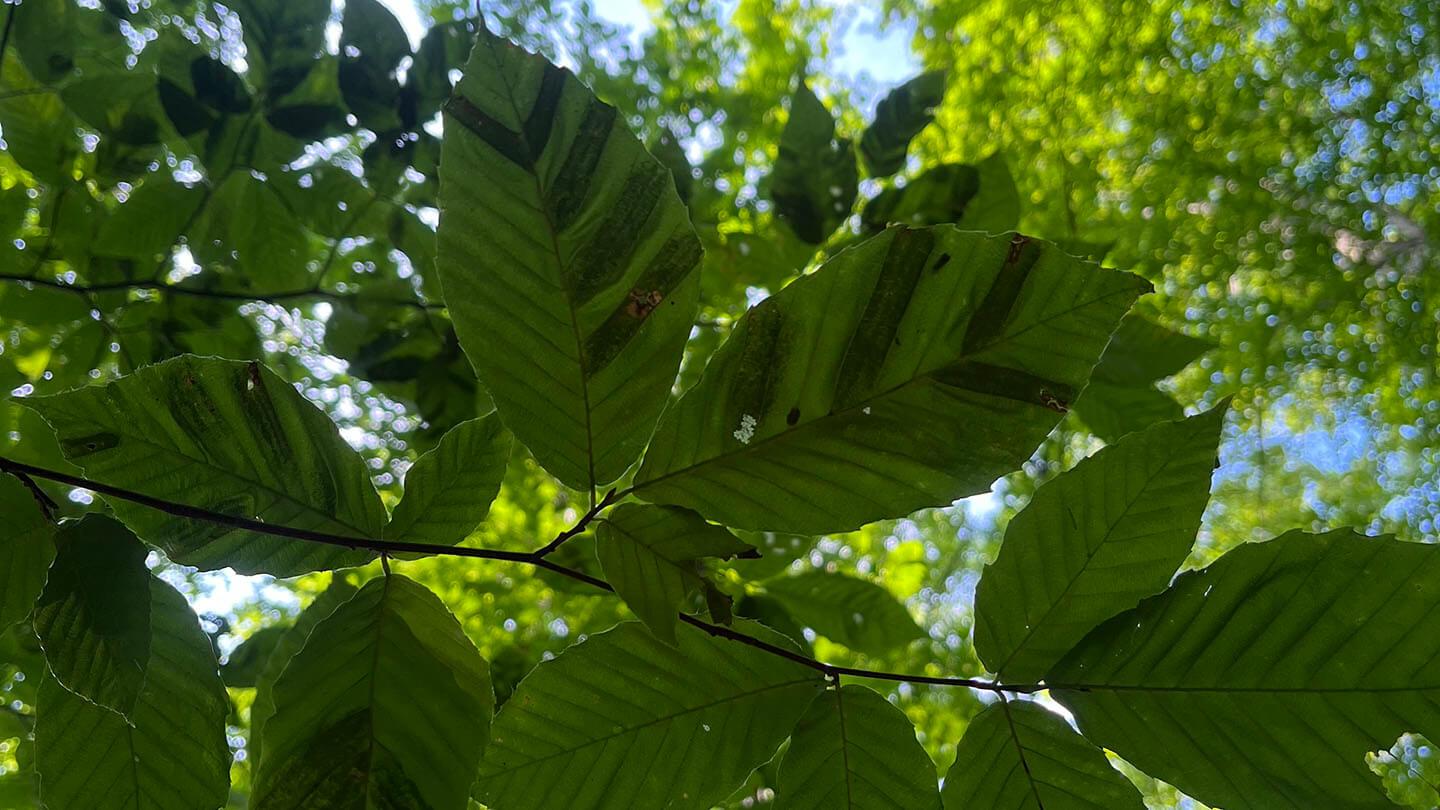Near the bottom of a shady hillside in Jericho, a lone beech tree stretches high into the canopy, a relic of a bygone forest.
Through luck or (hopefully) genetics, this mighty tree has avoided contracting beech bark disease—a fatal fungal pathogen that has proven deadly to mature beech trees. And it stands just outside a hotspot where a new pathogen called beech leaf disease (BLD) is spreading across Vermont forests.
“Beech is here a lot as a sapling … but if you look out into the forest it’s not really common in the overstory,” said Jess Wikle Ph.D. ’24, lecturer in forestry and manager of the University of Vermont’s Research Forests. “There is a reason for that.”
In the late 1800s, beech bark disease arrived in Nova Scotia and slowly expanded throughout Northeast forests. By the 1960s it was prevalent in Vermont. The disease is caused by infestations of a tiny scale insect that introduces a fungal infection to the vascular tissue of the tree. The once smooth beech bark gains a pock-marked appearance. While the disease progresses slowly, estimates suggest between 50 and 90 percent of mature beech eventually die from it.
“There are definitely way fewer big trees than there used to be,” said Wikle, “but there are still trees that have resisted the beech bark disease for a long time.”
The beech trees that do succumb often send out a series of root sprouts before they die, turning a forest of big trees into a thicket of saplings. Beech leaf disease is different. It seems to be spreading faster and young beech trees tend to die first.
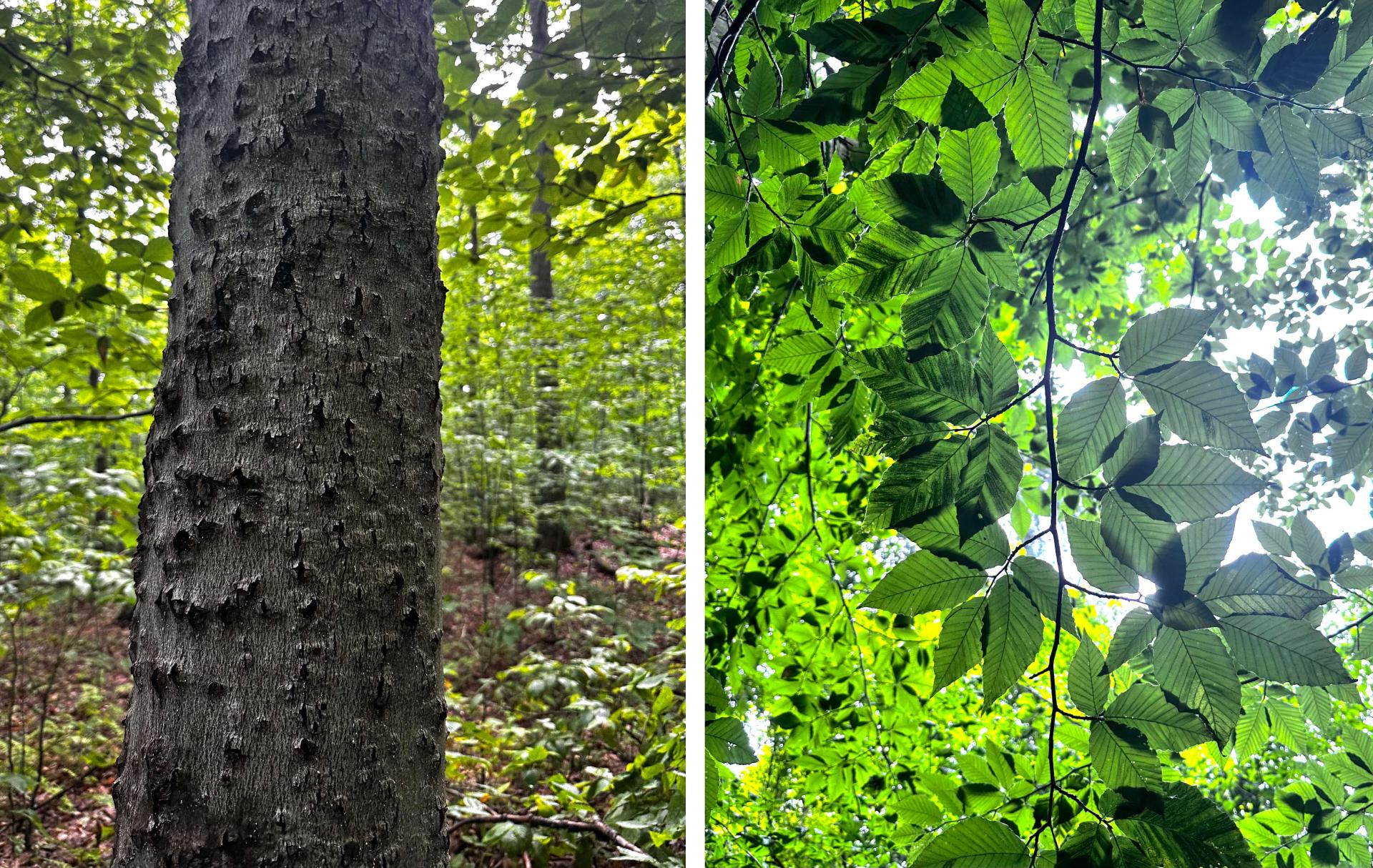
“Beech leaf disease is really scary because if it impacts those trees then we are losing our future seed sources,” Wikle said.
BLD first emerged in the United States in Ohio about a decade ago, likely by way of infected nursery stock from Asia, and has steadily expanded across eastern forests. Five counties in Vermont have confirmed outbreaks with the Jericho Research Forest as its northernmost point. That is why one morning in late June, Wikle and two UVM forestry interns met with scientists from Vermont’s Department of Forests, Parks & Recreation to map new infections. A cloud of mosquitoes hung in the air.
“We don’t know how beech leaf disease is spreading,” explained Savannah Ferreira, a forest pathologist for the state. “The leading hypothesis is that it’s wind—which is not good.”
Tracking a new forest pathogen
Last spring, Wikle was doing trail maintenance in the Jericho Research Forest when she reached for a branch and saw dark striping on a leaf—the telltale first sign of beech leaf disease.
“When you see it it’s a very distinctive symptom,” she said.
The disease is caused by a microscopic nematode that destroys the mesophyll layer in leaves where photosynthesis occurs. It becomes a chronic condition that deforms the leaf structure, gradually starving trees to death.
“When it showed up on the research forest I was like ‘This is terrible!'” Wikle said. “But also, if [beech leaf disease] could be anywhere at least it’s here and we can study it.”
She and a team of UVM students mapped the extent of the outbreak last fall with state and federal foresters, including Cameron McIntire, a plant pathologist with the U.S. Forest Service in New Hampshire. He collected leaf litter and soil samples to measure the rate of infection spread over time and to determine if the nematode is present in soils before visual symptoms occur in trees.
“We want to catch the edge,” explained Feirrera.
The Forest Service has monitored the progression of beech leaf disease for years and funds research projects to identify potential treatment and control methods for trees in landscaped and forested settings. While some interventions have shown promise such as fertilizer applications and injections, these are not scalable for forest stands—at least, not yet. But despite an uncertain prognosis, McIntire is not giving up on beech trees.
“We know very little about how BLD will affect long-term survival,” he wrote in an email. “It appears that American beech has very little natural resistance to BLD, and human intervention may be necessary to ensure healthy forests into the future.”
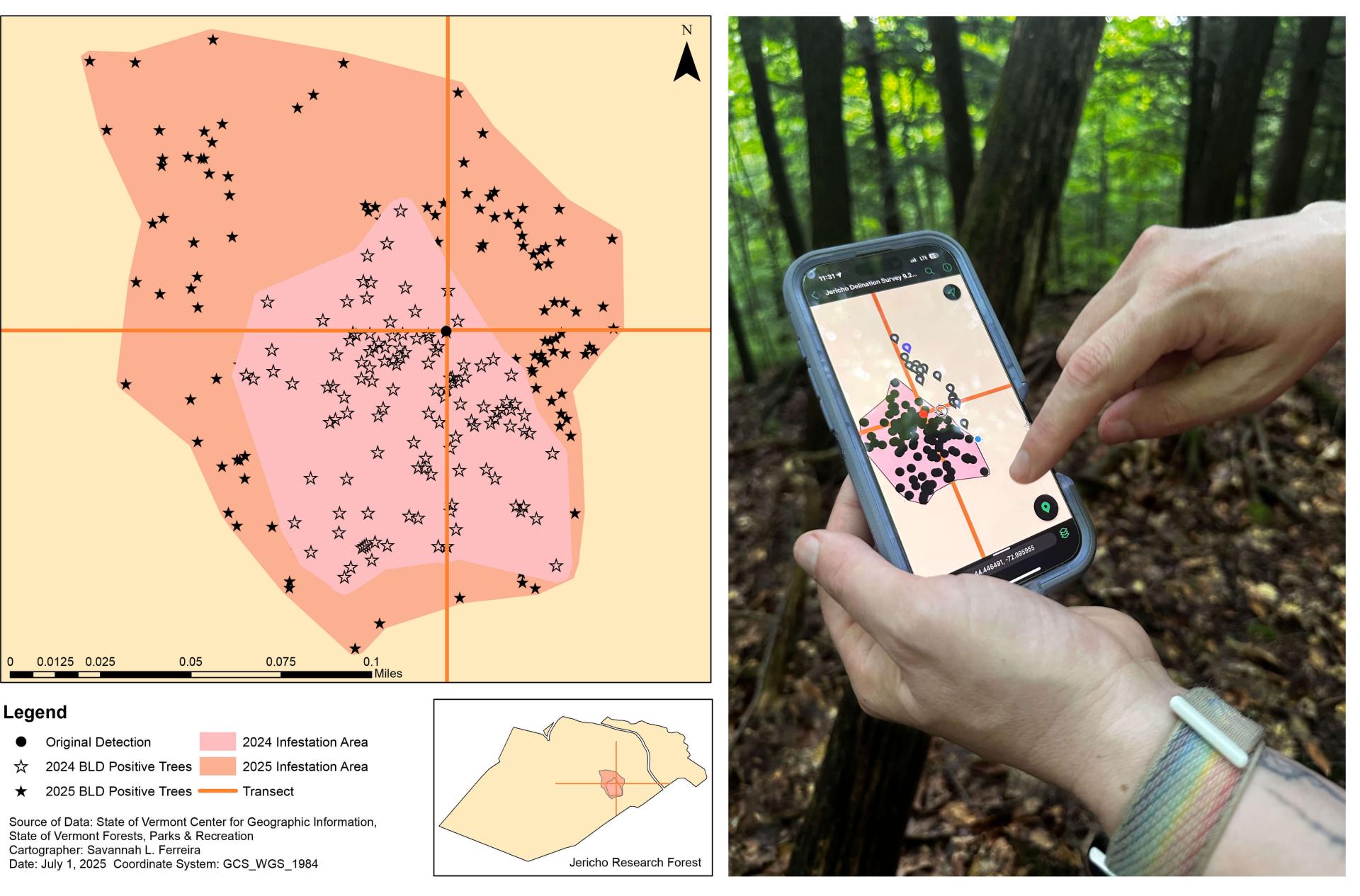
Mapping the spread
The untrained eye can easily miss detecting beech leaf disease. Sometimes only a single leaf on a branch will show banding. But pruning trees is not necessarily a viable management option.
“The nematodes are not visible to the human eye,” Wikle said. “So just because you don’t see it doesn’t mean they aren’t there.”
She worries the disease will be problematic in places such as northern Vermont where beech is the only masting tree that produce large quantities of nuts for species like bear, deer, and turkey across northern New England.
“Here in Chittenden County, there is oak as a backup, and hickory,” Wikle said.
Together we walked the northern transect of the forest, which mainly means hiking off tail and over fallen trees. We passed through patches of ferns, stopping every few feet to inspect trees along the route. Eventually we spotted a pristine beech specimen downslope. It looked like a stranger in its native forest with no sign of pockmarking, no sign of the wasting disease slowly marching through the forest.
“So many trees have succumbed to forest pests, I wish I could have seen these forests 100 years ago,” Wikle said.
Humans have transformed American forests for centuries as both Indigenous populations and early settlers shaped the landscape depending on their needs. Sometimes, our actions had unintended effects. In the early 1900s, an invasive blight disappeared most of the American chestnut from eastern forests. Global trade accelerated the pace of change as new invasive pests and pathogens have reduced the presence of elms and hemlocks. Once invasive species are released in new environments, they can be nearly impossible to stop.
"So many trees have succumbed to forest pests, I wish I could have seen these forests 100 years ago."- Jess Wikle
“It’s about co-evolution,” Wikle explained. “All of the native trees here have native pests that have been around for thousands of years. They co-evolved together so the trees have some defenses against them. …. But when [an invasive] pest gets to America, the trees have never had to respond to it before.”
Finding trees that show resistance to emerging biological threats is key to their survival.
Managing infected forests
People notice when wildfire wipes out a forest. But beech trees can live for years after becoming infected with beech leaf disease. This lag time can reduce the sense of urgency to the problem, explained Tony D’Amato, professor of forestry in the Rubenstein School of Environment and Natural Resources and director of the forestry program.
But this slow-moving killer also buys scientists a chance to learn about it and develop management plans. For instance, should we plant additional varieties of masting trees to support wildlife? Do we wait for beech survivors that have natural resistance to emerge? Do we double efforts to find treatments?
D’Amato studies adaptation strategies for forests in a time of rapid change because many forests are warming significantly faster than trees can naturally expand their range through seed dispersal. D’Amato’s projects involve testing assisted migration efforts such as planting species just beyond their historic range or to new sites within their existing range to study how they fare as the world warms.
We often look at trying to create redundancy to maintain forest function, said D’Amato. Diverse forests are more resilient when disturbances occur and by eastern standards, Vermont’s forests are diverse with over 30 tree species.
“We are lucky we already have a deck with more than two cards in it,” D’Amato said. As beech leaf disease spreads, he cautioned against taking action simply to do something. This is the time “to monitor and learn as much as we can,” he said. “No tree is immune to a chain saw.”
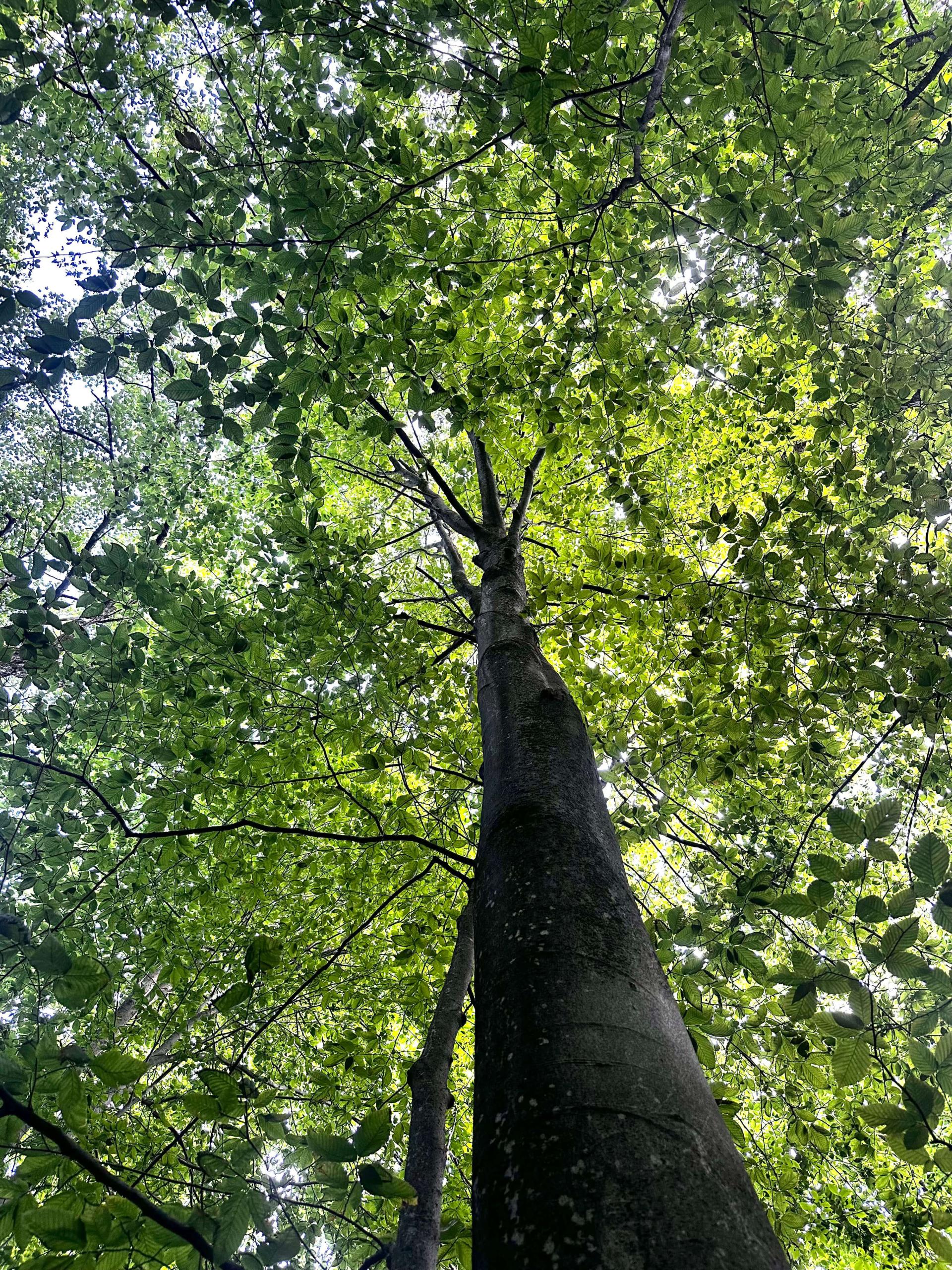
Zooming in on the problem
The tiny nematode behind this giant mess remains something of a mystery. Scientists have found the nematode can survive under snowpack, and it has been found inside insects, bird droppings, and spore traps. While it increasingly appears that the nematode is transported by wind and water, it may travel outside the advancing front by birds or on the bottom of a hiker’s shoe. Nick Aflitto, an assistant professor of forest health at UVM, aims to better understand this microscopic menace.
Nematodes don’t have great vision or acoustic signaling abilities, Aflitto said.
Learning how this species of nematode uses chemical signaling to find beech trees in the forest may also help stop them. Aflitto studies sensiochemical signaling such as the pheromones ants emit when they find a food source. Depending on the signature, compounds can greenlight a route or act as warning signs to danger ahead. Plants do this too.
Think of the smell of mown grass—Alflitto explained. Leaves munched by animals or insects produce a scent for other plants nearby to raise their defense systems.
“There is huge potential for using it for invasive species,” he said. “But we need to be able to detect them first.”
In the spring, Aflitto began attaching small rubber traps soaked in chemical compounds to diseased beech trees to attract the nematode and learn more about its behavior. His lab uses artificial intelligence to predict new biocontrols that may fast track the development of control methods for emerging forest pests.
“We have been manipulating the odorscape for a long time,” Aflitto said. “It does work.”
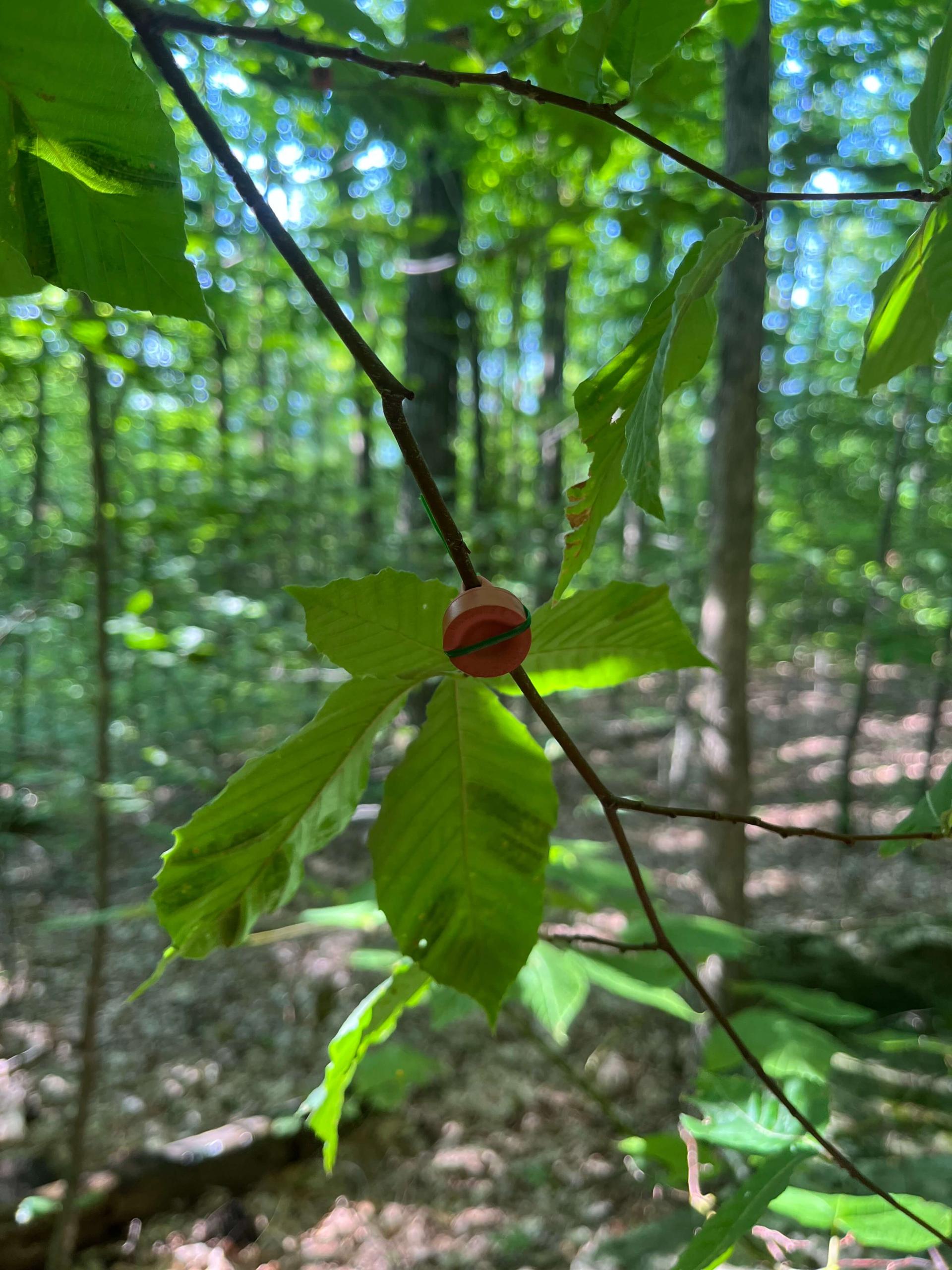
Using chemical compounds to attract or deter invasive species carries less risk of off-target effects than using biological controls such as introducing another species to an ecosystem to eat the invasive one.
“While we are getting better at it, we’ve seen that go wrong time and time again,” Aflitto said.
Holding out hope
Back in the Jericho Research Forest, the mapping team convenes at the epicenter of the outbreak. They tramp uphill to explore a vernal pool Ferreira flagged the year before as a site of interest.
“I think I have one over here,” said Mack Gamache, a rising senior, as he inspected a branch. Feirrera logged the point in her phone and continued forward. The woods quickly filled with a chorus of people confirming diseased trees. We aren’t far outside the perimeter of the initial outbreak, but each positive identification weighs heavily.
Gamache and Eli Gottman, a rising junior, recently measured a stand of chestnut trees planted over a decade ago as part of a research project to study how planted seedlings fare in the wild. About a third of the 400 planted died, Gamache said.
“But there were a lot of survivors,” Gamache said. “It’s a very optimistic feeling.”
The information could help foresters one day repopulate eastern forests with chestnut trees resistant to blight.
“It’s one piece of the puzzle,” Wikle said.
Feirrera hopes the next few years will yield even more.
When the emerald ash borer first emerged, it was alarming because of how little scientists knew about the problem, she said. “But now we have biocontrols for it; we have chemical controls for it. We know how to manage ash in the forest. We know that there are lingering naturally resistant ash trees. I think it’s going to be kind of shocking when we get this first wave of [beech leaf disease] spreading, but I am staying hopeful that we are going to learn a lot in the next couple of years.”
There are bright spots. Vermont was the last New England state to report beech leaf disease. There may be protective factors scientists haven’t uncovered yet. And while historically, beech is not a beloved tree for its economic benefits, beech has a high ecological value.
“They have their own network of mushrooms and wildlife that depend on them,” Feirrera said. “It does feel like a lot of doom and gloom, but there are a lot of eyes looking at this pest. I am staying hopeful that there is lingering beech.”
